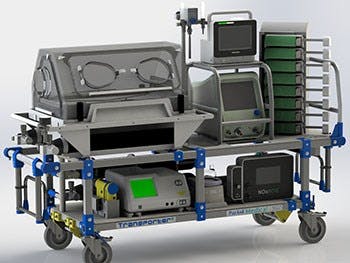Stretcher Interface Device designed to save babies' lives
 Researchers
Researchers
Supervisor: Dr Panch Suntharalingam
Background
Product design experts at Birmingham City University have teamed up with award-winning evacuation solution company Evac+Chair International to develop a device that will ensure newborn babies could survive should an ambulance crash.
Method
The Stretcher Interface Device (SID) will isolate the baby from sudden accelerations and decelerations to reduce the stress of road transport, with attach/release mechanisms that will see the device disengage from oxygen, power and other survival supplies in the event of a road traffic incident. The newborn will then be transferred quickly, via an incubator, to another ambulance vehicle.
SID will be impact tested at 40 miles per hour in a similar manner to how the Euro NCP verifies the fit and protection offered by child restraints in the event of a front or side crash.
The project has been made possible due to a knowledge transfer partnership between the Birmingham School of Architecture and Design, and Evac+Chair International. The terms of the programme will see a recent graduate from the University's Product and Furniture Design course employed to work on the two-year project.
Aims
The project will develop a SID with impact-resistant fixing points and ports for oxygen, power and other survival supplies situated around what encapsulates the newborn.
With more than 78,000 lives been saved since Euro NCAP's crash safety tests were launched in 1997, the University and Evac+Chair hope that their SID and related products will achieve a safety rating similar to those given on child restraint systems.
Research findings from the collaboration will also be fed in to the University's curriculum, ensuring that its teaching is informed by industry practice and innovation.